

4. Grand
Valley

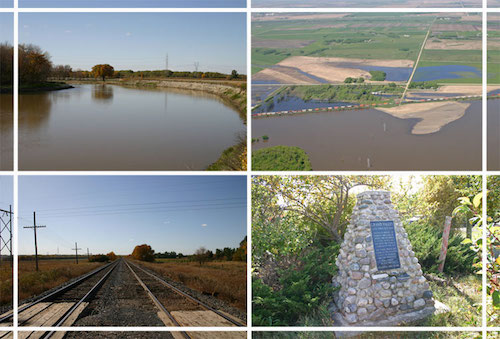
When
Dougald and John McVicar came west from Grenville Quebec, in 1878,
most settlers in what is now the Brandon region were selecting lands to
the north of the Assiniboine in the Little Saskatchewan Valley.
Here they were closer the Carlton or Saskatchewan Trail, the main
highway of the northwest, and nearer to the proposed CPR Route which
many assumed would follow the old fur traders route. Rapid City
was an established town and was soon to experience some rather reckless
land speculation based on the hope that the main line would cross the
river there. The McVicars chose, however, to travel due west from
Portage on the less traveled path, and selected land on the banks of
the Assiniboine, a few miles east of present day Brandon. And here they
soon were involved in one of the most celebrated transactions in the
“Manitoba Boom” of 1879 - 1882.
The first year was a lonely one.
They built a dugout home on the
north side of the river, and for a time there only human contacts were
the traders who passed by. The nearest place to purchase supplies
was at Rapid City, 35 miles away. The only othewr option was the
buffalo meat and pemmican that still could be had from Metis traders or
natives. In 1879 their wives and families arrived. They built
proper homes out of lumber from the Rapid City sawmill, and they were
on their way to becoming the leading citizens and premier entrepreneurs
of a rapidly growing settlement.
By the spring of 1879 the population was
over thirty. As usual,
newcomers were drawn by glowing accounts they had heard from friends
and relatives. A town was forming on the corner of
McVicar’s land, and by 1880 there was a collection of tents,
shacks, and a few log and lumber buildings. Businesses included several
general stores, a jewelry store, harness shop, bakery and
brickyard”. Travelers could stay at Brownlee’s comfortable
“Tent’ Hotel. A drug store was opened and a doctor
soon was in residence.
 The
"City of Winnipeg" at
Grand Valley (MB Archives)
The
"City of Winnipeg" at
Grand Valley (MB Archives)
As more settlers
arrived Dougald applied
for a Post Office and his wife
was appointed Postmistress. Mrs. McVicar passed on the
opportunity to have it named after herself and choose the name Grand
Valley, a name first suggested by a passer-by who had taken shelter at
their home. [1]
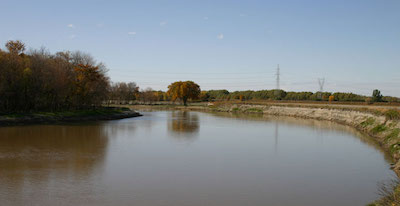
The
Grand Valley site in 2013.
The
arrival of the McVicars coincided with the beginning off steamboat
traffic on the upper Assiniboine, before long traffic on the river was
increasing as more settlers followed. In 1879 The Marquette would be
the first of the big riverboats to pass Grand Valley as it made its
historic trip to the northern reaches of the Assiniboine, and service
was quite regular after that. [2] The little settlement became quite an
important depot for supplies headed into the northwest, and one of the
regular scheduled stops along with Portage La Prairie, Cypress River,
Souris River and Fort Ellice. The McVicars, beginning to see that they
were perhaps in the right place at the right time, soon established
both a steamboat landing and a ferry crossing.
As early as the spring of 1880 the settlement’s advantageous
location was noted by railroad speculators who where already planning,
or rather, trying to anticipate, the transportation routes of the
future. A notice appeared in the Winnipeg Daily Times of an application
to Parliament to incorporate “The Grand Valley and Souris
Railway” from that “ a point on the Canadian Pacific
Railway about 120 miles west of the City of Winnipeg” to the coal
fields of Roche Percee in southeastern Saskatchewan. At that time the
C.P.R. wasn’t yet anywhere near Brandon, and indeed wasn’t
planning to pass that way. [3] But the Grand Valley settlement was
making a name for itself
In 1881, the railway engineers made an appearance amid speculation that
the CPR route might pass along the Assiniboine Valley instead going by
way of Rapid City as originally planned. [4] If so, a crossing would be
necessary somewhere in the vicinity, as the channel turns northwards
shortly after it passes present day Brandon. Aside from its
importance as a potential crossing, Grand Valley was by the spring of
1881 deemed worthy of regular stagecoach service from Winnipeg and a
recognized distribution centre. [5]
 Map
from "The
Assiniboine Basin"
Map
from "The
Assiniboine Basin"
When
Sanford
Fleming made his first trip west, he followed the well-established
Carlton Trail. Many early settlers expected that the railways would
naturally follow that route. Some, like those in Rapid City, hoped the
line would stay southwards before veering northwest to Fort Ellice.
(Map from "The National Dream")
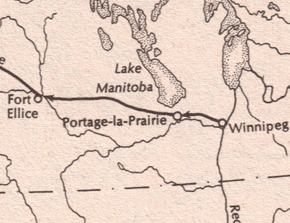
Fleming's Route
Crossings
were likely places for thriving settlements, but there was
more than a crossing at stake, there was the opportunity to become a
“divisional point”, something that was placed very 120
miles or so on a mail line. This meant even more commercial
opportunities. The McVicars, who had ignored railway speculation in
their original choice of a homestead, were now very interested.
As the C.P.R. marked out a roadbed and planned a river crossing, the
lots that John McVicar had had surveyed were selling for $2000 and the
population had expanded to 400. [6] The planned town site
was about a half a kilometre north of the river.
 Map
from Pierre
Berton's "The Last Spike
Map
from Pierre
Berton's "The Last Spike
One evening that
spring General Rosser of the C.P.R. offered John
McVicar $25000 for it. Spurred on, some said, by locals who
insisted he could get more, he held out for $50000 and Rosser soon
purchased land from D.H. Adamson who was squatting on a parcel of land
that lies from Victoria to Pacific Avenues, and from First to 9th
Street in present day Brandon. It was about 2 km west of Grand Valley
and that became the divisional point for the railway. The people
of Grand Valley, having lost their chance to become a major site were
prepared to settle for a siding. Deals were made, influence was
peddled, but alas it wasn’t to be. After losing out on a chance
to be major railway centre, two consecutive years of floods sealed the
fate of the community. [7]
It is interesting to note that this version of the story, which
appeared years later in the memoirs of Mr. Secretan, who was there when
it happened, was not widely circulated at the time and contemporary
reports focus more on the floods that made the site unattractive in the
springs of 1881 and 1882.
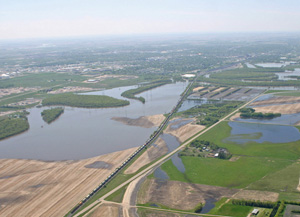
The
flood of 2011 must have been similar
to the ones in 1881 and 1882. The Grand Valley town site was about the
middle of this photo - under water. Note
that the bridge was not far from the Grand Valley site - but the
C.P.R. had decided that the new town (Brandon) would be on the
other side. Grand Valley was left not far enough away to merit
even a station and not close enough to profit from the Brandon site.
Another
interesting element is the intrigue surrounding just who owned the land
in the “Brandon’ town site. Records show that it was
actually owned by A.W.Ross of Winnipeg who on April 27, 1881 signed an
agreement with D.H. Adamson by which he gave up any claim in
consideration for one-seventh interest in the land. [8] The
speculation, advanced by most observers was that General Rosser and
Alpheus B. Stickney had engaged in some rather “sharp”
dealings behind the scenes which allowed them to profit considerably
from the sale of lots in Brandon. [9]
The Winnipeg papers of the time merely report that General Rosser had
established the crossing, the first mention of which comes on May 13,
1881 and still refers to the site as Grand Valley, the name Brandon
perhaps not yet chosen. [10] A May 16 report informs us that
Messrs Stickney and Drinkwater had located the station on section 23,
township 10, range 19; that “the station grounds were laid out by
General Rosser , and J.W. Vaughn, D.L.S. is laying out the town plot on
the above section,”. [11]
May of 1881 must have been a confusing time for Grand Valley residents,
future settlers, land speculators and prospective businessmen. A flurry
of display ads, appeared on a single page of the May 17 Winnipeg Daily
Times offering lots for sale. One ad offered lots at “Grand
Valley Crossing” the “Great City on the C.P.R. and crossing
of the Assiniboine River”. Another ad offers the (intentionally?)
misleading location as being “the C.P.R. crossing, Assiniboine
River, McVicar’s Landing, Grand Valley. “ Nearby an ad
announces the opening of a store at, “McVicar’s Landing,
Grand Valley” that they indicate is “Two minutes walk
to the C.P.R. crossing. “ None of thee ads used the name
“Brandon” yet back-to-back news items in the “What is
Going On Around Town” column of that same paper announce the
establishment of a brick-yard in Grand Valley and the establishment of
a hotel in the “new town of Brandon” [12] The confusion
might stem from the fact that the new town of Brandon had not
completely been distinguished from the existing established settlement
of Grand Valley. As of May 17, Brandon would have no post office, no
steamboat landing and no services. It existed only in theory, whereas
Grand Valley was a known commodity. I’m pretty sure that there
was no “McVicar’s Landing in the new townsite. Another
factor was that these ads were likely composed in Winnipeg by people
who quite literally didn’t know what they were talking about.
 Winnipeg
Daily Times, 25/05/81
Winnipeg
Daily Times, 25/05/81
A news report
on May
25 mentions that surveyor A.H. Vaughn arrived on the steamer Manitoba
with plans for “new town of Brandon”. [13] By May 28 the
steamer North-West had already landed at the new town site with a
"heavy consignment of lumber:" for pioneer merchants Whitehead &
Myer. [14] On May 28 an ad appears indicating plans are on view and
“Information Given for the “Town of Brandon, Grand
Valley” and a news report on June 9 still refers to the new town
as Brandon, Grand Valley in reporting that over $25000 in property had
been sold privately in the “past two days: [15] By July 8 the ads
offer, “Brandon City Lots” while noting that “the
post office at McVicar’s Landing is under six feet of water,
whilst Brandon is high and dry.” [16]
By late June the Rapid City Landing Warehouse established at Grand
Valley to serve the country to the north was moved to the new location,
and advertisements dated July 8, for the new steamer, the North
West, announce it’s departure for Grand Valley, Brandon and all
way points. [17] It was all happening very quickly.
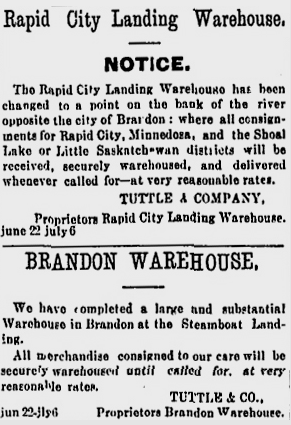 Winnipeg
Daily Times 22/06/81
Winnipeg
Daily Times 22/06/81
The summer passed with
the actual construction of the rail line
proceeding to a point on the river where bridge was constructed about a
mile to the west of the McVicar townsite. The locals still held out
hope that perhaps the actual station might be constructed to the east
of the crossing, giving their town a sliver of hope. Failing that there
was the possibility that a stations or at the very least, a siding
would confirm the existence of their town and offer some reason for its
continued survival. The trains however ran right on by, denying them
even a siding. [18]
By
November of
1882 Chater was being promoted as the new Grand Valley – with ads
claiming that it “has taken the place of Grand Valley in being
the distribution point for the settlements on the east side of the
Assiniboine River, and hold the same position on the east side of the
river that Brandon does on the west.” It goes on in this fashion
shamelessly. Who knows what the results were. [18] In 1882
Dougald McVicar sold the town site for $1500. He soon moved to
Brandon where he established a brickyard. A decade later we find him
with another brickyard, this time in Sydney. [20]
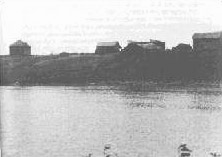
Grand Valley
Townsite,
after the boom.
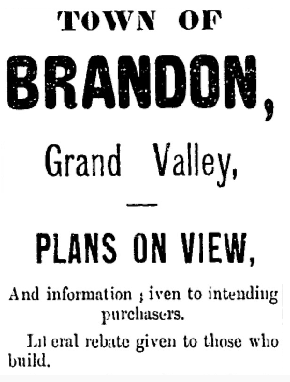
On July 8, 1881 the Winnioag Times was running these ads.
A tree nursery occupies the site today (2008) and a cairn
explains the significance of the spot. Otherwise one would pass by
without know about one of the most short-lived of the of the first wave
of Westman settlements.

Sources
1. Heeney, Isabelle, B., Grand Valley, A Boom Town 1878-1885 Manitoba
Pageant, Summer 1979, Volume 24, Number 4 and; 3. Kavanagh,
Martin, The Assiniboine Basin,The Gresham Press, Old Woking,
Surrey, England 105-108
2. Winnipeg Daily Times 23/05/79
3. Winnipeg Daily Times 02/04/80
4. Kavanagh, Martin, The Assiniboine Basin,The Gresham Press, Old
Woking, Surrey, England 109
5 Winnipeg Daily Times 30/05/81
6. Heeney
7. Secretan, James Henry Edward,Canada's great highway: From the first
stake to the last spike (Ottawa: Thorburn & Abbott, 1924), 125-128;
Berton. Pierre, The Last Spike (Toronto: McLelland and Stewart
Ltd., Toronto 1974), 25; Berton relates conflicting accounts by J.H.E.
Secretan, a CPR surveyor and memoirs of Charles Aeneas Shaw, a
“locating engineer”; Doerksen, A. D., The Brandon
Wheat Kings - 1887 Vintage (Manitoba Pageant, Winter 1977, Volume 22,
Number 1) favours the account of Trotter. The evidence indicates,
at the very least, a lost oportunity for McVicar and the Grand
Valley speculators.
Kavanaugh 141 Brandon Sun Weekly 13/01/87
8. Kavanagh 141
9. Cruise, David and Griffiths, Alison, Lords of the Line, 129
10. Winnipeg Daily Times 13/05/81
11. Winnipeg Daily Times 16/05/81
12. Winnipeg Daily Times 17//05/81
13. Winnipeg Daily Times 25/05/81
14. Brandon Manitoba, Canada, and her industries, Steen & Boyce
Publishers 1882
15. Winnipeg Daily Times 09/06/81 & 28.05.81
16. Winnipeg Daily Times 08/07/81
17. Winnipeg Daily Times 22/06/81 & 05/07/81
18. Kavanagh, 113-116
19. Winnipeg Daily Times 08.11.82
20. Footsteps in the Sand, Sydney History (Find)
21. Brandon Sun Weekly 11/12/84
22. Brandon Sun Weekly 05/06/84
|
|
|